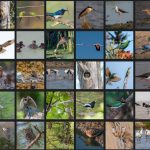
Admittedly this has never crossed my mind as being remotely interesting, young birds are generally awkward things, not yet fitting into the sleek and streamlined expectation of the dictionary definition of “bird”. Furthermore, thrushes are often underappreciated creatures on their own. Many times a result of their ubiquity around our homes. But then we hear them singing, and we become smitten.
Their sweet song is often in contrast to many of their other vocalizations, some of which can be a bit jarring. The scolding alarm call of the Spectacled Thrush for example is something that I grew extremely tired of – the birds would sit on our window and glare at our indoor cat and yell (what I presume to be some form of obscene insult) at him.
But at times, in the breeding season especially, the same birds would belt some of the most complex and absolutely juicy notes that made me reconsider my feelings toward them. They seem to be a bit angry for the most part. After all, if one were to search the word “thrush” on the internet, the top result is the fungal infection. Clearly a maddening situation for any right-thinking thrush.
I’ve grown to enjoy them over the years, however. On a recent walk through the Main Ridge Forest Reserve in Tobago we saw a few thrushes that were still in the process of learning their environment and exploring their world and this got me thinking of all the young thrushes I had the pleasure of knowing throughout my life. Back in Trinidad, both Spectacled Thrush and Cocoa Thrush would nest in our backyard. This gave us several chances to experience them at various stages of growth.

A pair of Spectacled Thrushes at the very commencement of their noisy life.

This Cocoa Thrush seemed to be contemplating whether leaving the nest was a good idea after all.

It may seem like a grown bird, but the rufous tips on the wing coverts of this Cocoa Thrush tell us it is still in its first year of life.
I had never seen other young thrushes before that last walk I just mentioned as the other species tend to breed in more remote environments far away from concentrated human settlement. Wise creatures.

First on the trail was a very vocal (albeit not yet melodious) Yellow-legged Thrush.

Although I have seen many a White-necked Thrush over the years, I never before saw a young one. The rufous edging on many of its feathers shone brightly in the darkness of the rainforest.
There is great joy in birding, but combined with a philosophy of experiencing each individual with a clean slate without expectation is definitely something that elicits tremendous emotion. Surely I could’ve written off each sighting as one of a species I had seen before – but the question must be asked: have I truly seen a species after seeing a few individuals?












Leave a Comment